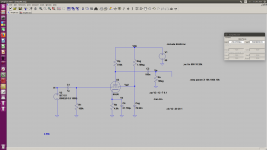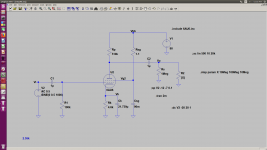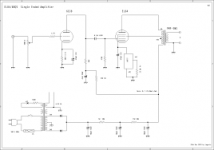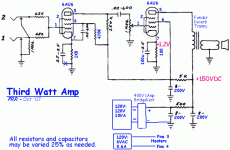Hello all,
I am currently getting my hands dirty in DIY vacuum tube amplifiers! To start learning the basics, I am creating a very simple resistance coupled Class A amplifier using the 6AU6A tube.
I am aware that this tube is not the best when it comes to power amplifiers. I am currently restricting myself to only use components I have. At a later date, I will be creating a 300 W + amplifier with all of the right tubes. For now, the first amplifier is more of a learning experience.
Anyways, I have this circuit that I am working with that I obtained from the datasheet of the 6AU6A (screenshot of the circuit is attached below). I started doing some impedance matching on the circuit and it turns out, I can only get about 10 mW out of the circuit (In config 1, I can get up to 10 mW. In config 2, I get up to 700 uW!). This is a problem because I am wanting to drive a 15 W speaker with this circuit. I am currently investigating how to determine the max power of the circuit. In the meantime, I have a few questions for the community regarding this:
1) What are some tips on optimizing a vacuum tube circuit?
2) I hate to be blunt but really, what is going on here! Why is my output power so low!
Thank you and any assistance is greatly appreciated!
I am currently getting my hands dirty in DIY vacuum tube amplifiers! To start learning the basics, I am creating a very simple resistance coupled Class A amplifier using the 6AU6A tube.
I am aware that this tube is not the best when it comes to power amplifiers. I am currently restricting myself to only use components I have. At a later date, I will be creating a 300 W + amplifier with all of the right tubes. For now, the first amplifier is more of a learning experience.
Anyways, I have this circuit that I am working with that I obtained from the datasheet of the 6AU6A (screenshot of the circuit is attached below). I started doing some impedance matching on the circuit and it turns out, I can only get about 10 mW out of the circuit (In config 1, I can get up to 10 mW. In config 2, I get up to 700 uW!). This is a problem because I am wanting to drive a 15 W speaker with this circuit. I am currently investigating how to determine the max power of the circuit. In the meantime, I have a few questions for the community regarding this:
1) What are some tips on optimizing a vacuum tube circuit?
2) I hate to be blunt but really, what is going on here! Why is my output power so low!
Thank you and any assistance is greatly appreciated!
Attachments
Audio amplifiers made with pentodes may amplify with much lower than a simpler triode, but find the wright point is very hard task. Yo have at least 4 variables: plate, screen and cathode bias and plate current (Screen current is a fixed % of the plate current). So, play with 4 variables isn't a simple task.
When simulating circuits, use standard values. Is of no sense using 46.78µF as the standard value is 47µF and the usual tolerance is of ±20%, Then such a unusual value is of no sense.
In the other hand, to make an amplifier with tubes capable of 300W is by far, a very complex task.
When simulating circuits, use standard values. Is of no sense using 46.78µF as the standard value is 47µF and the usual tolerance is of ±20%, Then such a unusual value is of no sense.
In the other hand, to make an amplifier with tubes capable of 300W is by far, a very complex task.
Audio amplifiers made with pentodes may amplify with much lower than a simpler triode, but find the wright point is very hard task. Yo have at least 4 variables: plate, screen and cathode bias and plate current (Screen current is a fixed % of the plate current). So, play with 4 variables isn't a simple task.
When simulating circuits, use standard values. Is of no sense using 46.78µF as the standard value is 47µF and the usual tolerance is of ±20%, Then such a unusual value is of no sense.
In the other hand, to make an amplifier with tubes capable of 300W is by far, a very complex task.
Yeah, that is why I am first making a 20 W amplifier in order to learn the basics
If you are just starting in tube amplifying, I humbly suggest to start with a well probed circuit. For example, if you want a 5W amplifier, a ECL82 may give, say, 3W with few components, few space and in only one socket. Still a 20W amplifier with tubes is a bit difficult to who has no experience.
Please note I am trying not to be offender, only I give my own experience in electronics, I have about 30 years in this matter. Ham radio from 1987 when I started with a 6DQ6 transmitter (Only 30W) in the simpler 80mts band.
IMHO I suggest to start with a simplest tube like the above mentioned, or any other of this kind.
I also want to explain you that tubes need high voltages mixed to lower ones (250V for plates and 6.3 for heaters, for example) and a mistake may cause personal injury and burns or explosions.
Please note I am trying not to be offender, only I give my own experience in electronics, I have about 30 years in this matter. Ham radio from 1987 when I started with a 6DQ6 transmitter (Only 30W) in the simpler 80mts band.
IMHO I suggest to start with a simplest tube like the above mentioned, or any other of this kind.
I also want to explain you that tubes need high voltages mixed to lower ones (250V for plates and 6.3 for heaters, for example) and a mistake may cause personal injury and burns or explosions.
Last edited:
Yeah, that is why I am first making a 20 W amplifier in order to learn the basics
Tubes in general, are each designed for a specific purpose.
To think that a small signal tube can be used successfully as an audio output is bad thinking.
Output tubes are larger, with larger plates, and can handle the currents/voltages that small signal tubes cannot.
Even the popular EL84/6BQ5 output tube when used in push-pull service can only put out about 17 watts maximum under ideal conditions.
Learn what tubes are designed for, and forget "what I have in the junk box that I can use"
The RCA receiving tubes handbook is loaded with good information and reading.
It would be wise to spend the time doing that first.
These are all triode valves, again only good for a voltage gain stage.I see, well, in my box of stuff, I have
4x 6BK4
3x 12J5
6SN7
I agree with the contributors above.
You could add a pentode valve power stage. Check out an EL84 single ended (Class A) circuit for example.
You don't need many watts to go loud with a speaker of average sensitivity. It's amazing how loud a couple of watts can be from a valve amp!
Attachments
Hey all! Thank you so much for all of the valuable feedback! I am still going through it all. It seems that none of the tubes that I have are ideal for a power amplifier hence the reason that I am having a hard time getting the output power I need.
For those wondering, I do have a degree in engineering (electrical). I mostly worked with digital! So this is my first foray into analog electronics. Still a noob nonetheless.
Are there any parameter(s) in the datasheet that I should be looking at that will indicate if the tube is a good candidate for power amplifying?
For those wondering, I do have a degree in engineering (electrical). I mostly worked with digital! So this is my first foray into analog electronics. Still a noob nonetheless.
Are there any parameter(s) in the datasheet that I should be looking at that will indicate if the tube is a good candidate for power amplifying?
Hello all,
I am currently getting my hands dirty in DIY vacuum tube amplifiers! To start learning the basics, I am creating a very simple resistance coupled Class A amplifier using the 6AU6A tube.
I've started this hobby up again too in the past 6 months, 35 years ago was the last time I made anything with tubes! Back then I made some regenerative radios and small amps from the "The Boys Book of Radio Electronics" series. Now in retirement I'm revisiting a hobby I loved in my teens.
I found it easier to start out bread-boarding with the simplest headphone amplifier circuits I could find. Get some sound to the headphones, learn how to measure voltages and current, learn how to insert 1 ohm resistors wherever you want to monitor current, learn how to hook up several meters to see how the currents change/relate, etc... Doing little headphone amps let me know 100 things my bench was missing, 100 more things I had to learn about measuring, 100 more things about fabrication and layout, 100 more things about theory, and unfortunately 100 more parts I want to buy, etc... Jumping into an amp with a lot of watts at first may not be as productive learning-wise.
You cant get much simpler than this headphone amp, not much to screw up:
Papa Rusa Headphone Amplifier – wauwatosa tube factory
There are many very simple headphone amps out there, and the OTL ones are even simpler.
They seem to have missed teaching some fundementals.
If you are going to criticize someone's education, best to get the spelling right
The various facets of electronics all have their own specific fundamental elements.
When a customer at my service counter professed to having a degree in electrical engineering, I asked him a simple question about biasing a solid state amplifier.
He couldn't answer.
I then asked him about the universal resistor code - what would the value be of a Brown/Black/Orange resistor.
Again, a blank face and no answer.

When a customer at my service counter professed to having a degree in electrical engineering, I asked him a simple question about biasing a solid state amplifier.
He couldn't answer.
I then asked him about the universal resistor code - what would the value be of a Brown/Black/Orange resistor.
Again, a blank face and no answer.
> What are some tips on optimizing a vacuum tube circuit?
ANY circuit:
How does the power get from the battery to the load?
Here you have 90V battery and the only path to load is a 510,000r resistor.
Even if all that power were useful output it could only be 15.8 milliwatts.
You want much lower plate resistor and probably higher battery voltage.
Also: a resistor-loaded "power" amplifier is at-best 8% efficient. Choke or transformer loading can approach 50%. With practical power devices and power supplies, above flea-watt, you really can't do resistance-coupling.
You can't build a house out of any practical number of toothpicks.
6AU6 is not a big tube. It can pull a 15k load and with 160V supply transformer-coupled it can deliver about 1/3rd Watt of lightly distorted audio.
Have you done any looking-around? There are zillions of tube amp plans on the Web. There's even a bunch on THIS forum! 20W tube amps are common, but don't use 6AU6 as power tubes.
A 300 Watt tube amp will require buying big tubes. Hardly anybody but George has them in the shop already. Ampex SVT (early) and Fender 300 are example 300W amps. These used sextets of -selected- 6550 bottles. Even the driver was bigger than a 6AU6 (the 300 used a hot-worked 6V6).
ANY circuit:
How does the power get from the battery to the load?
Here you have 90V battery and the only path to load is a 510,000r resistor.
Even if all that power were useful output it could only be 15.8 milliwatts.
You want much lower plate resistor and probably higher battery voltage.
Also: a resistor-loaded "power" amplifier is at-best 8% efficient. Choke or transformer loading can approach 50%. With practical power devices and power supplies, above flea-watt, you really can't do resistance-coupling.
You can't build a house out of any practical number of toothpicks.
6AU6 is not a big tube. It can pull a 15k load and with 160V supply transformer-coupled it can deliver about 1/3rd Watt of lightly distorted audio.
Have you done any looking-around? There are zillions of tube amp plans on the Web. There's even a bunch on THIS forum! 20W tube amps are common, but don't use 6AU6 as power tubes.
A 300 Watt tube amp will require buying big tubes. Hardly anybody but George has them in the shop already. Ampex SVT (early) and Fender 300 are example 300W amps. These used sextets of -selected- 6550 bottles. Even the driver was bigger than a 6AU6 (the 300 used a hot-worked 6V6).
Attachments
Tube datasheets give recommendations for various classes of operation, and usually list output power.
Power tubes need a lot more filament power, so that's a good place to check.
If it doesn't say power output, its almost certainly not a power output tube! Most
power output tubes are beam tetrodes, so that's a good clue too.
Miniature (9 pin base) tubes are seldom more than a few watts output, because they would melt otherwise.
RF transmitting tubes run much hotter(*) and can handle way more power as a result, but require attention to cooling.
(*) Far too hot to touch.
Power tubes need a lot more filament power, so that's a good place to check.
If it doesn't say power output, its almost certainly not a power output tube! Most
power output tubes are beam tetrodes, so that's a good clue too.
Miniature (9 pin base) tubes are seldom more than a few watts output, because they would melt otherwise.
RF transmitting tubes run much hotter(*) and can handle way more power as a result, but require attention to cooling.
(*) Far too hot to touch.
Last edited:
If you are conveniently in the US, ESRC has a list of cheap $1 tubes.
Summer Dollar Days - Vacuum Tube Sale - $1.00 Vacuum Tubes
Not many real POWER tubes on the $1 list, but a few are:
12BQ6GT, 6KY8, 6MF8, 12HE7, 6DB5, 6GF5
Then there is a bigger 21JV6 for $4, and 6LU8 for $5, and 6JN6 or 6GE5 for $6.
6KY8, 6MF8 and 6LU8 have the front end triodes in the same bottle as the power beam tetrode.
One such tube can make a complete single ended amplifier. Two such tubes can make a complete push-pull power amplifier. With an Output Transformer of course. (6MF8 oriented toward higher voltages, lower currents than the others)
Try to find tubes with similar heater voltages (1st digit or two) unless you already have several adjustable low voltage power supplies handy. (recommend starting with 6GF5 or 6GE5/6JN6, 6KY8 or 6LU8)
The 6GF5 does not have plate curves on it's datasheet, but it is nearly identical to 6GE5, except for the power rating, and that has design curves on its datasheet) 6GE5 plugs into the same socket pin-out as the 6GF5 if you want to upgrade power.
Amplifier designs are around on the WWW for 6JN6/6GE5 and for 6LU8.
Two 6LU8 can get you 20 to 25 Watts output. Two 6JN6/6GE5 or 21JV6 can get you 30 to 35 Watts output in class AB.
Summer Dollar Days - Vacuum Tube Sale - $1.00 Vacuum Tubes
Not many real POWER tubes on the $1 list, but a few are:
12BQ6GT, 6KY8, 6MF8, 12HE7, 6DB5, 6GF5
Then there is a bigger 21JV6 for $4, and 6LU8 for $5, and 6JN6 or 6GE5 for $6.
6KY8, 6MF8 and 6LU8 have the front end triodes in the same bottle as the power beam tetrode.
One such tube can make a complete single ended amplifier. Two such tubes can make a complete push-pull power amplifier. With an Output Transformer of course. (6MF8 oriented toward higher voltages, lower currents than the others)
Try to find tubes with similar heater voltages (1st digit or two) unless you already have several adjustable low voltage power supplies handy. (recommend starting with 6GF5 or 6GE5/6JN6, 6KY8 or 6LU8)
The 6GF5 does not have plate curves on it's datasheet, but it is nearly identical to 6GE5, except for the power rating, and that has design curves on its datasheet) 6GE5 plugs into the same socket pin-out as the 6GF5 if you want to upgrade power.
Amplifier designs are around on the WWW for 6JN6/6GE5 and for 6LU8.
Two 6LU8 can get you 20 to 25 Watts output. Two 6JN6/6GE5 or 21JV6 can get you 30 to 35 Watts output in class AB.
Last edited:
- Status
- This old topic is closed. If you want to reopen this topic, contact a moderator using the "Report Post" button.
- Home
- Amplifiers
- Tubes / Valves
- Need help optimizing circuit



